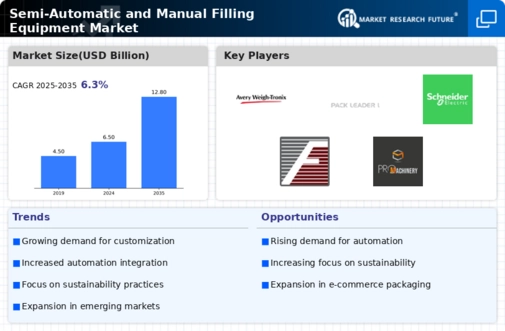Market Growth Projections
The Global Semi-Automatic and Manual Filling Equipment Market Industry is poised for substantial growth in the coming years. With a projected market size of 6.5 USD Billion in 2024, the industry is expected to expand significantly, reaching an estimated 12.8 USD Billion by 2035. This growth trajectory suggests a compound annual growth rate of 6.34% from 2025 to 2035. Factors contributing to this expansion include rising automation demands, advancements in technology, and an increasing focus on sustainability. As industries continue to evolve, the filling equipment market is likely to adapt, offering innovative solutions to meet the changing needs of manufacturers.
Rising Demand for Automation
The Global Semi-Automatic and Manual Filling Equipment Market Industry experiences a notable increase in demand for automation across various sectors. Industries such as food and beverage, pharmaceuticals, and cosmetics are increasingly adopting semi-automatic filling solutions to enhance productivity and reduce labor costs. The market is projected to reach 6.5 USD Billion in 2024, driven by the need for efficiency and precision in filling processes. Companies are investing in advanced technologies that allow for faster production rates while maintaining quality standards. This trend indicates a shift towards more automated solutions, potentially leading to a more streamlined manufacturing environment.
Growth in E-Commerce and Online Retail
The Global Semi-Automatic and Manual Filling Equipment Market Industry is significantly influenced by the growth of e-commerce and online retail. As more businesses transition to online platforms, the demand for efficient packaging and filling solutions rises. This shift necessitates the use of semi-automatic filling equipment to meet the increasing volume of orders while ensuring consistency and quality. The market is expected to expand as companies seek to optimize their operations to cater to the growing consumer base. This trend suggests a robust future for filling equipment, with projections indicating a market size of 12.8 USD Billion by 2035.
Sustainability and Eco-Friendly Practices
Sustainability is becoming increasingly important in the Global Semi-Automatic and Manual Filling Equipment Market Industry. Companies are recognizing the need to adopt eco-friendly practices in their operations, including the use of sustainable materials and energy-efficient equipment. This shift towards sustainability not only addresses environmental concerns but also appeals to a growing consumer base that prioritizes eco-conscious products. As businesses strive to reduce their carbon footprint, the demand for semi-automatic filling equipment that aligns with these values is likely to increase. This trend indicates a potential for growth as companies invest in sustainable solutions to meet both regulatory and consumer expectations.
Regulatory Compliance and Quality Assurance
In the Global Semi-Automatic and Manual Filling Equipment Market Industry, adherence to regulatory standards is paramount. Industries such as pharmaceuticals and food production are subject to stringent regulations that mandate precise filling processes to ensure product safety and quality. As companies strive to comply with these regulations, the demand for reliable filling equipment increases. Semi-automatic systems often provide the necessary accuracy and traceability required for compliance, thereby enhancing their appeal. This focus on quality assurance is likely to drive market growth, as businesses invest in equipment that meets regulatory demands while maintaining operational efficiency.
Technological Advancements in Filling Equipment
Technological advancements play a crucial role in shaping the Global Semi-Automatic and Manual Filling Equipment Market Industry. Innovations such as smart sensors, IoT integration, and machine learning are transforming traditional filling processes into more efficient and adaptable systems. These technologies enable real-time monitoring and adjustments, enhancing the overall performance of filling equipment. As manufacturers seek to improve their operational capabilities, the adoption of these advanced technologies is expected to rise. This trend may contribute to a compound annual growth rate of 6.34% from 2025 to 2035, reflecting the industry's commitment to modernization and efficiency.

















Leave a Comment